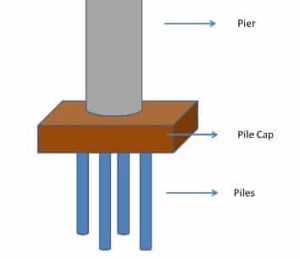
A structure essentially consists of two parts, namely the super structure which is above the plinth level and the substructure which is below the plinth level. Substructure is otherwise known as the foundation and this forms the base for any structure. Generally about 30% of the total construction cost is spent on the foundation. The soil on which the foundation rests is called the “Foundation Soil”.
Objectives of a Foundation
A foundation is provided for the following purposes:
- To distribute the total load coming on the structure on a larger area.
- To support the structures.
- To give enough stability to the structures against various disturbing forces, such as wind and rain.
- To prepare a level surface for concreting and masonry work.
Types of Foundation
- Shallow Foundation
- Isolated Foundation
- Combined Footing
- Deep Foundation
- Pile Foundation
- Pier Foundation
Shallow Foundation
A shallow foundation is sometimes defined as one whose depth is smaller than its width. Shallow foundation can be laid using open excavation by allowing natural slopes on all sides. This is normally convenient above the water table and is practicable upto a depth of about 5m. Shallow foundation transfers the load to the ground by bearing at the bottom of the foundation.

- Isolated Footing
In framed structures where several columns are to be constructed, isolated footings can be adopted. If masonry footing is provided, steps are given and the foundation area is thus increased so that the stresses developed at the base is within the limit.

- Combined Footing
This type of footing is adopted when the space between two columns is so small that the foundation for individual columns will overlap. Combined footings are proportioned in such a way that the centre of gravity of the loads coincides with the centre of gravity of the foundation. Hence these footings have either a trapezoidal or a rectangular shape.

Deep Foundation
A deep foundation s defined as one whose depth is larger than its width. Deep foundations cannot be laid using open excavation. Deep foundation transfer the load to the ground partly by end bearing at the bottom of the foundation and partly by skin friction with the soil around the foundation along its embedment in the soil.

- Pile Foundation
Piles are structural members that are made of steel, concrete, and/or timber. They are used to build pile foundations, which are deep and which cost more than shallow foundations. Despite the cost, the use of piles often is necessary to ensure structural safety.
- Pier Foundation
A pier foundation consists of a cylindrical column of large diameter to support and transfer large super-imposed loads to the firm strata below. The difference between Pile foundation and Pier foundation lies in the method of construction.



